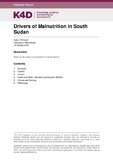| dc.description.abstract | This rapid review synthesises the literature from academic, policy and NGO sources on the drivers of malnutrition in South Sudan. The conflict and lack of a resolution is the key driver and much of the other issues are closely connected to the conflict. UNICEF argue that the main contributing factors to high malnutrition rates in South Sudan are the unprecedented high levels of food insecurity, widespread conflict and insecurity, population displacement, poor access to services, high morbidity, extremely poor diet (in terms of both quality and quantity), low coverage of sanitation facilities and poor hygiene practices (UNICEF, 2017c). Key findings are as follows: first, the population of South Sudan mainly relies on farming, fishing or herding for their livelihoods, but displacement due to conflict has forced people to abandon their source of income and food. Second, displacement also puts a strain on the resources available in areas hosting those displaced. Third, the forced migration of cattle herders leads to the spread of bovine diseases, the loss of cattle and less production of milk. Fourth, the return of people to their areas of origin puts a strain on food resources as food production does not march the population numbers. Fifth, the conflict and resulting insecurity makes it difficult to deliver aid to much of the country and restricts access to safe water and basic sanitation facilities leading to malnutrition and the lack of treatment for the same. Sixth, whilst structural constraints connected to historic poor governance, corruption, the lack of investment in infrastructure, and striking inequality across the country also drive food insecurity. Furthermore, fighting has restricted the planting of seeds, meaning that even though there was decent rainfall in 2018 not enough crops were planted to take advantage and therefore, the conflict food prices have increased dramatically. As a result, many in South Sudan only eat one, nutrient-poor, meal a day. Next, South Sudan’s health system is in dire condition as a result of the conflict, which means people are not being treated at the early stages of malnutrition or for diseases that exacerbate malnutrition, such as cholera. Finally, the Fall Armyworm was first reported in South Sudan in 2017 and has spread across the country, it has led to significant crop loss in the major staple crops in South Sudan maize and sorghum. | en |

